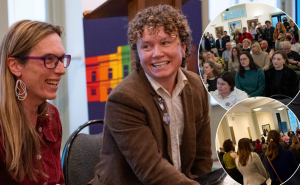
Following the wave of anti-trans sentiment directed towards Algerian boxer Imane Khelif Dr Antimony Deor unpacks the differences between transgender and intersex people and their lives.
Sex is often thought of as an essential, singular characteristic that can be identified instantly.
But it’s more like a delicate symphony of chromosomes, hormones, internal organs and external anatomy that builds up over time. Usually these elements work in concert to give us the classic categories of man and woman that we all know and love.
But like anything in nature, things aren’t always so neat and simple.
The latest gender controversy has involved two women athletes who have been accused of failing an unspecified gender test.
Activists have called them transgender, muddling the distinction between the two unique communities.
The trans and intersex experiences are connected, but distinct. This short explainer delve into the histories and realities of the two terms, examining their unique characteristics and how they shape our understanding of gender diversity.
Living life as a trans man
I’m trans, which means that the gender everyone assumed I was when I was born isn’t the one in which I feel happiest.
For me, personally, having a nonbinary body and being perceived as nonbinary or masculine is comfortable in a way that my female body never was.
I have (or used to have) the XX chromosomes, body parts and hormonal profile associated with typical womanhood, but I chose to alter some of these things, and now my life is much better.
Trans people generally find that the sex they were presumed at birth isn’t actually the one they feel themselves to really be, and so they voluntarily go through medical, social or legal changes to align their body, relationships, or legal status with their true identity.
The history of the 20th century is the history of people trying to do this the other way around – change the mind to fit the body – which didn’t work as effectively to alleviate this dissonance.
Understanding Intersex
Intersex, or differences of sexual development, is a very broad umbrella term encompassing dozens of different conditions affecting a person’s reproductive, endocrine, genetic or anatomical features.
Rather than the usual XX or XY, some people have XXY, XXXY, XXX or just a single X chromosome.
Some people have XY chromosomes but are impervious to testosterone, so they develop as female.
Some people have XX chromosomes, but produce so much testosterone they develop male characteristics.
Some people have XX chromosomes but the gene on the Y chromosome that usually directs sexual development somehow transferred to an X chromosome, so they develop as male. Some people absorb their twin in the womb so their bodies are a mixed mosaic of two different sets of genes.
Unexpected hormones from wayward glands can affect the development of a fetus, direction of a puberty, or development of typical sex characteristics, while conditions that affect receptors can mean that hormones have reduced effects or just aren’t received at all.
Sometimes, like any other part of the body, external anatomy just doesn’t develop typically, and so a baby’s genitalia might appear ambiguous at birth. Sometimes things look pretty standard on the outside, but reproductive organs develop atypically, or not at all, on the inside.
Until very recently, surgery was performed on these children to make their bodies conform to a binary sex – the decision of male or female anatomy often not based on anything but the type of procedure that would be easiest to perform.
However, not all intersex conditions are visible at birth. Many people don’t know they’re intersex until they experience an unusual puberty, try for a baby and find out they’re infertile, have their chromosomes or hormones checked for some other reason, or, apparently, are diagnosed over the internet by right-wingers.
Intersex and trans
This means that intersex people can also be trans, if the sex they were assigned at birth doesn’t match their internal reality.
They might take medical or social steps to transition from the sex they were presumed to be – or made to be – to one that better fits them.
This might involve similar medications or procedures to the ones available to non-intersex trans people, but might also differ depending on their unique biology.
United by a common cause
Trans and intersex people are not the same group of people, and their histories and experiences are often very different.
While trans people feel a difference between their physical appearance and internal sense of gender and seek to align their body and mind, intersex people are born with physical traits that don’t conform to typical male or female categories and face unique medical and social challenges related to their conditions.
However, one thing unites trans people and people with disorders of sexual development: we’ve been politicised by religious and ideological extremists who see us as unnatural and a threat to their worldview.



